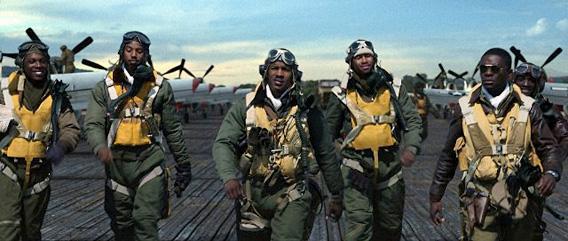You can’t help but root for Red Tails (Lucasfilm). Ostensibly a biopic about the prejudices faced by the Tuskegee Airmen, World War II’s African-American flyboys, Red Tails is really a fantasy about blowing up racist German airmen and then shouting, “Whoo!” George Lucas, who produced the movie, has said that he was forced to finance it on his own—to the tune of $58 million—when studios balked at the marketability of a film with all black leads. But while this may have been a passion project for the Star Wars director, Red Tails is sadly just as shoddy as the other recent products to emerge from Skywalker Ranch, condescending to its audience and stretching the boundaries of belief. Remember that scene from Raiders of the Lost Ark, when a swastika-stamped Nazi crate explodes for no good reason (beyond the fact that the Ark hates Nazis)? Red Tails is like that, only less awesome, and considerably longer.
Director Anthony Hemingway opens the movie with a massive (and massively disorienting) air battle, as if not trusting his audience to bear even a minute without some vroom and boom. “Germans. Let’s get ’em,” intones a nameless white pilot. It’s only after we witness the demise of several of his fellow white flyers—nicely subverting the old cliché that it’s always the black guy that’s the first to go—that we meet the Tuskegee Airmen, who for the moment are far from the action, stuck with orders to complete a less distinguished mission. The young Tuskegee pilots dream of dogfighting with the Luftwaffe’s finest, but for the time being their most deadly competition is a German supply train.
Soon enough, however, small victories lead to more respect for the airmen, which in turn leads to more exciting missions—and so on, in a tedious if action-packed cycle. Along the way, historical context is kept to a minimum in favor of loop-the-loops and nose dives. Hemingway cut his teeth directing episodes of David Simon’s HBO series The Wire and Treme, two of television’s finest studies of black America. But Red Tails has little interest in exploring where these pilots came from, or the adversity they will continue to face when they return home. There’s not even any explanation of what makes the Tuskegees such stellar flyers (perhaps their midi-chlorian count?). The main subplot finds the aces courting local bombshells in the Sicilian countryside (it seems that racism was absent in idyllic Allied Italy) to which composer Terrence Blanchard—who’s done some exciting work with Spike Lee—brings the light touch of sighing accordions. (The snare-rolling score for the air battles is similarly ham-fisted, but the sound design, which can take on the psychedelic quality of the Transformers franchise, is among the film’s few strengths.)
Terrence Howard and Cuba Gooding Jr. get sole billing in the film’s posters, but their screen time is scant. The real stars are Nate Parker’s Easy and David Oyelowo’s Lightning (as in Top Gun, the pilots use call signs), who both in their style of fighting and their politics represent a Martin and Malcolm dichotomy: Easy is the patient team player, Lightning the uncompromising maverick. Oyelowo fares well as the charismatic hot shot, while Parker is as solid as a character made of cardboard can be. Gooding Jr., who as a young man would have been wonderful as one of the excitable pilots, is miscast as an earthbound major, projecting authority mainly by smoking a pipe meaningfully. Fans of The Wire can pass the time spotting actors from the series: Michael B. Jordan and Tristan Wilds play two eager aviators, and Andre Royo, who played Bubbles, again works with scrap metal as a dutiful mechanic. (IMDb tells me that Method Man was in there somewhere, too, but his appearance is so brief I missed it.) It’s good to see these talented actors finding work, yet painful to see them saddled with such leaden dialogue. At one point, a pilot who has passed out from blood loss wakes up and exclaims, “I must have passed out,” which is helpful if you have, too.
Though Hemingway is credited as the director, the old-fashioned cheese and effects-driven vacuousness on display here are classic George Lucas. In a New York Times Magazine article by Slate columnist Bryan Curtis this week, Lucas explains that “If it’s a popcorn movie … it needs a lot of corn.” That may be true, but entertaining your audience doesn’t mean you need to treat them like idiots who can’t handle so much as a minute of exposition. Lucas fans who didn’t give up on him after Jar Jar, or Greedo-gate, may enjoy some of his signature touches here—one of the characters carries around a Buck Rogers toy gun, echoing Lucas’ own fondness for the serial hero, and lines like “Red Two to Red Four” seem to reveal old inspirations—but no one is going to mistake Red Tails for the next Star Wars. Lucas, who will soon have directed fewer films than Terrence Malick, also told the Times that this may be his last blockbuster, and that he’d like to retire to make smaller, more personal films. (Then again, he’s been spouting that line for years now.) But if Red Tails rakes it in at the box office, Lucas claims he’ll hand the reins to Spike Lee or Precious director Lee Daniels for big-budget sequels and, of course, prequels. I can imagine Daniels conveying these pilots’ inner struggles as they wrestle with their place in the war, and Lee capturing the lives they lived before they won their wings. Those movies I’d like to see.
